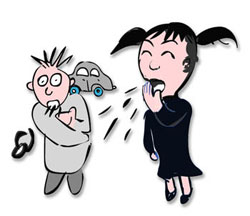
Up to 30% of Europe's urban population is exposed to ozone
concentrations above the threshold levels set by the EU to protect
health.
The main health effects of
short-term (a few hours) exposure to ozone include irritation of throat
and eyes, coughing, wheezing, inflammation of lungs and difficulties in
breathing.
These effects may occur in people with respiratory diseases,
children and the elderly when the ozone concentration reaches a level
higher than 180 µg/m3 (EU information threshold).
Above 240 µg/m3 (EU alert threshold), health effects
will be increasingly severe and may be experienced by most individuals.
See also: How can I protect my health?
Ozone at high concentrations leads to health problems, because it
attacks the lining of our lungs. This can cause lung inflammation
(irritation) even after only a few hours of exposure. Our airways
respond to the exposure by covering the affected areas with fluid and
by contracting the lung muscles. Breathing becomes more difficult and
lung capacity decreases.
The lungs will usually recover within a few days after exposure to
elevated concentrations of ozone. However, if ozone exposure is
experienced over a longer period of time or on a number of repeated
occasions within a year, chronic damage to lung tissue may occur. This
means that the lung function may be affected and the lining may lose
some of its ability to serve as a protective barrier against microbes,
harmful chemicals and allergens.
Also, recent research studies suggest that long-term exposure to
ozone may be associated with lung cancer. This possibility is expected
to be further explored.
|
health effects of short-term
exposure
|
health effects of long-term exposure
|
|
Irritation of eyes and throat
|
Damages to lung tissue cells
|
|
Adverse effects on lung function
|
Reduction in lung function development
|
|
Aggravation of respiratory symptons such
as asthma
|
|
|
Increase in medication usage
|
|
|
Increase in hospital admissions
|
|
|
Increase in mortality
|
|
Table. Health effects associated with exposure
to ozone. (Adapted from WHO
2004)
Asthma
Ozone can aggravate asthma and may also worsen other respiratory
illnesses such as pneumonia and bronchitis. Evidence shows that when
ozone concentrations are high, asthmatics have more attacks than usual
and need more medication.
There is little evidence, however, to support the suggestion that
the long-term upward trend in ozone pollution is the reason for the
growing number of asthmatics. Asthma is now the most common respiratory
disease among western European children, afflicting 7 % of children
aged between 4 and 10.

Children’s health
Children are particularly sensitive to air pollution, because they
breathe more air per kilogram of body weight and have smaller lungs
than adults. Also, children – especially newborn babies – are
vulnerable because their metabolism and lung defence mechanisms are not
fully developed.
Evidence indicates that long-term ozone exposure reduces the
development of the lung function in children. This may contribute to a
shorter life expectancy, because decreased lung function is one of the
strongest predictors of increased mortality in adults.
There is also evidence that high exposure to ozone increases the
occurrence of lung infections (e.g. pneumonia and coughing) in
children.


Document Actions
Share with others